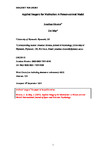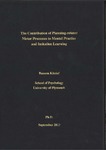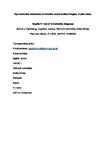Imagery training for athletes with low imagery abilities
| dc.contributor.author | Rhodes, J | |
| dc.contributor.author | Nedza, K | |
| dc.contributor.author | May, J | |
| dc.contributor.author | Clements, L | |
| dc.date.accessioned | 2024-04-09T08:29:59Z | |
| dc.date.available | 2024-04-09T08:29:59Z | |
| dc.date.issued | 2024-04-08 | |
| dc.identifier.issn | 1041-3200 | |
| dc.identifier.issn | 1533-1571 | |
| dc.identifier.uri | https://pearl.plymouth.ac.uk/handle/10026.1/22255 | |
| dc.description.abstract |
Imagery training, specifically visual and kinesthetic imagery training, is a well-established method of increasing performance in sport. However, some athletes may have impoverished imagery abilities (e.g., aphantasia; low visual imagery) which may hinder performance increments that benefit others. We administered the Plymouth Sensory Imagery Questionnaire (Psi-Q) which tests multisensory imagery, to 329 participants from nine different sports across two levels: semiprofessional and professional. This formed the baseline test, finding no significant differences between sport or level for imagery ability. The Psi-Q located 27 low imagers (mean total scores <4.2/10), including seven non-visual imagers, three non-auditory, seven non-olfactory, and five non-gustatory imagers, and one across all senses. We split the sample randomly into two groups and immediately delivered the imagery intervention, Functional Imagery Training (FIT) to the first group (over two weeks), followed by delivering the same intervention to the wait group. A wait period was due to the lengthy delivery time of the personalized intervention. Both groups received the intervention for the same duration ending in a Psi-Q retest after the intervention. In both groups, FIT increased overall imagery scores which was maintained six months after intervention completion. This indicates that imagery can be trained and maintained in those with a low ability. Follow up interviews (n = 22) explored how imagery was being used beyond the intervention, revealing that the majority now use imagery to plan and manage thinking. Recommendations are given for ways to train imagery in an applied sport setting and future research in broader areas is detailed. Lay summary: We identified 27 individuals with low multi-sensory imagery scores, and used Functional Imagery Training (FIT) to produce enduring improvements in imagery ability, positioning FIT as a valuable tool for enhancing cognitive skills in sports. | |
| dc.format.extent | 1-14 | |
| dc.language | en | |
| dc.publisher | Informa UK Limited | |
| dc.subject | Aphantasia | |
| dc.subject | imagery | |
| dc.subject | functional imagery training | |
| dc.subject | applied imagery for motivation | |
| dc.title | Imagery training for athletes with low imagery abilities | |
| dc.type | journal-article | |
| dc.type | Article | |
| dc.type | Early Access | |
| plymouth.issue | ahead-of-print | |
| plymouth.volume | ahead-of-print | |
| plymouth.publisher-url | http://dx.doi.org/10.1080/10413200.2024.2337019 | |
| plymouth.publication-status | Published online | |
| plymouth.journal | Journal of Applied Sport Psychology | |
| dc.identifier.doi | 10.1080/10413200.2024.2337019 | |
| plymouth.organisational-group | |Plymouth | |
| plymouth.organisational-group | |Plymouth|Research Groups | |
| plymouth.organisational-group | |Plymouth|Research Groups|Centre for Brain, Cognition and Behaviour (CBCB) | |
| plymouth.organisational-group | |Plymouth|Research Groups|Centre for Brain, Cognition and Behaviour (CBCB)|Behaviour | |
| plymouth.organisational-group | |Plymouth|Faculty of Health | |
| plymouth.organisational-group | |Plymouth|Faculty of Health|School of Psychology | |
| plymouth.organisational-group | |Plymouth|Research Groups|Institute of Health and Community | |
| plymouth.organisational-group | |Plymouth|REF 2021 Researchers by UoA | |
| plymouth.organisational-group | |Plymouth|Users by role | |
| plymouth.organisational-group | |Plymouth|Users by role|Current Academic staff | |
| plymouth.organisational-group | |Plymouth|REF 2021 Researchers by UoA|UoA04 Psychology, Psychiatry and Neuroscience | |
| plymouth.organisational-group | |Plymouth|REF 2021 Researchers by UoA|UoA04 Psychology, Psychiatry and Neuroscience|UoA04 REF peer reviewers | |
| plymouth.organisational-group | |Plymouth|REF 2029 Researchers by UoA | |
| plymouth.organisational-group | |Plymouth|REF 2029 Researchers by UoA|UoA04 Psychology, Psychiatry and Neuroscience | |
| dcterms.dateAccepted | 2024-03-27 | |
| dc.date.updated | 2024-04-09T08:29:58Z | |
| dc.rights.embargodate | 2024-4-11 | |
| dc.identifier.eissn | 1533-1571 | |
| rioxxterms.versionofrecord | 10.1080/10413200.2024.2337019 |




